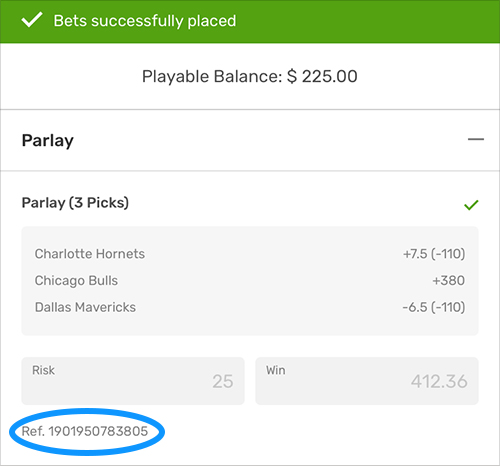Parlay Bet Definition
A parlay bet is a wager that links several single bets together to form one bet. The winnings from every single bet are reinvested into the next leg of the parlay. A parlay bet is also called an accumulator bet, and on first glance appears to be the same as a multi bet. By definition, a parlay is a group of multiple individual bets (two or more) that are connected together and treated as one big wager. In order to win the entire bet, you have to win each of the individual bets on your parlay. If you lose one individual bet, then you lose the entire parlay bet. Definition of parlay (Entry 2 of 2): a series of two or more bets so set up in advance that the original stake plus its winnings are risked on the successive wagers broadly: the fresh risking of an original stake together with its winnings. Keep scrolling for more.
If you're the gambling type, you may already know that parlay can also be used as a noun describing a series of bets in which a person places a bet, then puts the.
You may be confused as to what that means. For years it was a battle cry amongst my roommates and me, particularly during football season, and when you got to yell it, chances were you were buying drinks that night. But what does it mean, and what’s a parlay?
What is a Parlay?

A parlay is a type of sports bet in which you combine multiple individual bets (typically 2-10 bets) into one bet or “card.” Combining the bets gives you worse odds to win, but a larger reward for winning. The larger the amount of wagers included in your parlay, the larger the payout.
In order for a parlay bet to win, you must win each individual bet on the card. For instance, let’s say I bet the Patriots, the Ravens and the Texans all to win their games on any given Sunday. If all three win, I will get a much larger payout than if I just bet each game individually. However, if any of those teams lose their bet, the entire card is lost.
The only exception is in the case of a “push,” which is the gambling term for a tie. If one of the games on the card pushes, that wager is removed from the parlay. So, in the case of our three team bet above, if the Ravens tied their game, it becomes a two bet parlay. If the Patriots and Texans then win their games, the bet pays out as a 2 team parlay. The payout will be smaller than if they all three won, but hey, you still win some money!
While the odds of winning large parlays (5-10 wagers combined) are relatively low, they allow you to risk a small amount of money for a potentially large reward. For instance, a 10 team parlay bet purchased for $25 would pay out over $16,000 if you won every game.
Now that you understand the basics, let’s look at what kinds of bets you’ll be pairing together to make your fortune!

Types of Parlays
Over/ Unders
Over/Under bets (or bets on the “total) are wagers made on the total amount of points that will be scored during any given game by both teams. The sports book sets the “line,” which is the number you will be basing your decision on. You bet on whether you think the total amount of points scored will be over or under that number.
Over/Under, or Totals, bets are very common in betting parlays because they allow you to make multiple bets on the same game. A common strategy is to bet which team you think will win, and then parlay that bet with whether you think the game will go “under” or “over.”
So, let’s say your Uncle Tony got a tip that Aaron Rogers has a secret shoulder injury, and it will be difficult for Green Bay to throw the ball. The line is set a 53.5. Plus, they are playing the Browns, so you still think they will still win. You may want to bet Green Bay and the under. So you are betting that Green Bay will win the game, but it may be lower scoring due to the injury, and thus the total points scored by both teams will be less than 53.5.
You may have noticed the half a point I included in the example above. In sports betting these half points are called “the hook.” The sportsbooks use half points for most bets, especially over/unders, which limit the opportunities for a push. They “hook” bettors into one side of the bet or the other.
Point Spreads
Point Spreads, commonly referred to just as “the spread,” are what makes sports betting interesting. Without them, we could all just bet the favored team every week, make a lot of money and break Vegas within a month.
A point spread evens the playing field between teams by taking points from the favored team and giving them to the underdog. So, for instance, the Chiefs are playing the Colts in what is expected to be a tightly contested game. The Colts are favored to win by a field goal.


On the sportsbook board, or the betting site, this would look like “Colts -3” or “Chiefs +3,” depending on which side you wanted to bet. So, if you bet the Colts -3, but the Colts win by 1, you actually lost that bet by 2 points. If you bet the Chiefs +3, congratulations, you won!
How many points the underdog gets, or the size of “the spread,” depends on how mismatched the teams are. In the NFL, the spread rarely goes about 13.5 or so, but in sports like college football, you routinely have teams cover 60 point spreads.
While the point spreads themselves add a degree of complication to the bets, there are additional options that can really add to the fun. They’re called Teasers and Pleasers—my heart rate picks up a little just typing those words out for you!

Teasers
As far as I’m concerned, Teaser parlays are the greatest thing to happen to sports betting since the invention of the online casino. A teaser bet allows you to move that point spread that we discussed above in a way that’s favorable to you, the bettor (typically between 6 and 7.5 points). You get less of a payout if you win a teaser parlay, but it does improve your odds of winning.
So, in the example of the Colts and the Chiefs above, we had the Colts favored by 3 points. If you “teased the line” 6 points, then you’d move that Colts spread from -3 to +3.
You add 6 points to the spread that’s already given. Now you have a bet on the team that’s already favored, and now you win your bet whether they win outright as is predicted, or if they lose by less than 3. I like your chances!
What’s even better is that you don’t have to just tease the point spread, you can tease the total or over/under as well! So, if the point spread was 53.5 as it was in our example earlier, you could tease that line all the way down to 46.5 (7 point teaser), and then bet the over. Or, you could bet the under by moving the over/under up to 60.5. Like taking candy from a baby.
Pleasers
A parlay is a single bet that links together two or more individual wagers for a high payout. A 2 team parlay might pay 13/5, a three team parlay might pay 6/1, a four team parlay might pay 10/1, and so forth with the payouts getting higher with more teams or totals selected. For a single bet, 2 to 8 teams or totals can be selected.
Parlay Bet Rules
In order for the parlay bet to win, every one of the wagers must win or push (tie). If any of the selections lose, your wager loses, regardless of the outcome or cancellation of the other games. If one or more selections is a tie, postponed, incomplete, cancelled or rescheduled for another day, then the wager reverts to the next lowest number. For example, if you place a 5 team parlay and have 4 winners and a tie, your wager pays out as a 4 team parlay. If you place a 2 team parlay and one team wins and one ties, the wager becomes a straight bet.
Parlay Bet Definition Game
The resulting wager will have the same risk amount with the win being calculated to reflect the odds of the remaining team (Example: On a two team $100 parlay with team A +110 and team B -110 if A ties and B wins the resulting wager will be a straight play on B risking $100 to win $91).